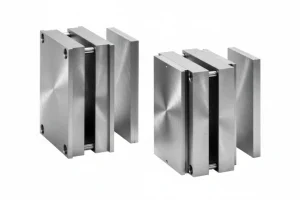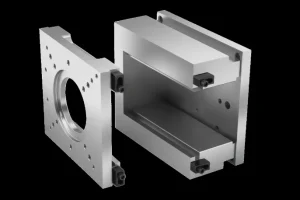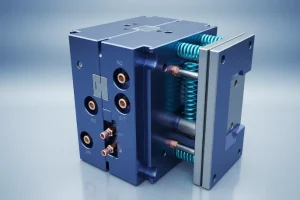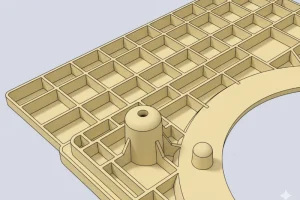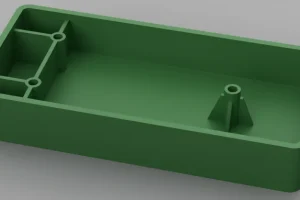Introduction: Injection molding is a manufacturing process that goes by many names, depending on the material being used. One of those materials is ABS, and this article will be all about ABS plastic molding.

What is ABS for Injection Molding?
ABS stands for Acrylonitrile Butadiene Styrene. It’s a plastic made up of three monomers, each of which contributes its own properties to the polymer plastic, giving it a wide range of performance.

ABS has a lot of good stuff going for it. It’s got chemical resistance, hardness, and heat resistance. It’s got impact resistance and toughness from butadiene, and strength and gloss from styrene. And it’s one of the cheapest plastics. Plus, it’s one of the easiest plastics to use for injection molding because it’s so easy to process.
Why Choose ABS as an Injection Molding Material?
ABS is a strong and tough plastic, but it is not so good with UV rays. So, you can’t use it outside. But, people who make parts have figured out how to change ABS by adding things to it. They add things like acrylic, glass, and stainless steel fibers to make it so it can be used outside. These things change the way ABS works, so you can use it for lots of things.

These properties and manipulation potential make ABS the most widely used polymer in the injection molding process. Want to learn how this plastic is used to create a variety of finished products? Then, keep reading next.
What is the ABS Injection Molding Process Like?
Material Pretreatment
Before you use ABS plastic for production, you need to dry it properly. The drying temperature you use is 80 – 85°C for 2 – 4 hours. Another way to dry it is to use a drying hopper with a temperature of 80°C. But you can only do that for 1 – 2 hours.

Calibration of the Injection Molding Machine
After you have the material ready, the next step is to set up the ABS injection molding machine. This means setting parameters like the compression ratio, clamping force, and injection pressure. Typical values for these parameters are: compression ratio greater than 2, clamping force between 4700 and 62000t/m², injection pressure greater than 1500 bar.

Mold and Gate Design
The mold is very important for the molding of ABS products. So, designing the mold and gate is very important for the entire injection molding process. Typically, the thickness of ABS molds is between 0.025 – 0.05 mm, while the gate length is set below 1 mm.

In addition, the diameter of the channel through which the molten ABS flows is set to 3 mm, while the width of the ventilation holes is 4 – 6 mm. Finally, the mold temperature is always maintained between 60 – 65°C.
Injection Temperature
The temperature you use to inject ABS plastic into a mold depends on the type of ABS you’re using. Here are some common types of ABS plastic and the temperatures you should use to mold them:

Flame retardant grade: 200 – 240°C, best temperature is 220°C – 230°C;
Electroplating grade: 250 – 275°C, best temperature is 270°C;
Glass fiber reinforced grade: 230°C – 270°C;
High impact grade: 220°C – 260°C, best temperature is 250°C;
Heat resistant grade: 240°C – 280°C, best temperature is 265°C – 270°C.
Injection Molding Speed
The speed of injection molding depends on the grade of ABS plastic and the requirements of the finished product. For example, flame retardant ABS plastic can only use slower injection molding speeds. Additionally, products that require precise surface treatment may require high-speed injection molding.

Dwell Time
Dwell time is the time it takes for plastic to travel from the barrel of the injection molding machine to the mold. For ABS, the dwell time is usually 5-6 minutes at temperatures below 265°C. However, for flame retardant grades of ABS, the dwell time is shorter and the temperature is lower.
Back Pressure
To prevent wear, it is recommended to keep the back pressure as low as possible during ABS injection molding. Acceptable pressures are usually around 5 bar.

Cleaning
Some grades of ABS have a tendency to stick to the screw of the mold after the part is ejected. Therefore, the best way to clean it is to wait for the residue to grind off and then clean the injection molding machine compartment thoroughly with polystyrene.
What are the Advantages of ABS Injection Molding?
ABS injection molding is, like, one of the most popular plastic molding methods ever. And there’s a good reason for that. There are a lot of advantages to using ABS injection molding. Some of these advantages include:

High Injection Molding
ABS is a plastic that is easy to work with, so you can make complex parts with it. It’s a hard plastic, so you can make parts that work well, even in tough conditions.
High Tensile Strength
ABS molded parts have a high tensile strength, which makes them suitable for applications that need to support heavy loads. This plastic can withstand great mechanical shocks, making it an affordable option for high-stretch applications.

Recyclability
ABS is a great material to recycle because it can be broken down and mixed with new ABS to make new parts.
Energy Efficiency
Machines for ABS plastic molding are great at processing this thermoplastic. They’re powerful and strong, so they can do it over and over. Energy-efficient systems can also help you save energy and time.

Versatile Applications
ABS plastic molding also ensures versatile applications. The process is suitable for a wide range of ABS resins in various sizes, with excellent integration capabilities. This flexibility ensures the production of components for a wide range of industries.

Accurate Reproducibility
ABS injection molding is a process that makes complex parts for complex applications. It’s usually limited to other injection molding processes.

The ability to use complementary technologies and controlled injection molding ensures that shapes are made the same way every time and that molded parts are high quality. Plus, this material keeps its characteristics and performance even when it gets really hot or really cold.
What are the Disadvantages of ABS Injection Molding?
ABS, like anything else, has its downsides. Some of these downsides include
Poor Fatigue Resistance
While ABS parts are usually strong, they can’t handle heavy loads for long because they don’t resist fatigue well. ABS plastic parts can break down if they’re always in high-stress situations.

Poor UV Resistance
One of the big disadvantages of ABS plastic is that it doesn’t hold up well in sunlight. It breaks down pretty easily when it’s exposed to sunlight. But, when they make parts out of ABS plastic, they put additives in it to make it hold up better in sunlight.

High Smoke Evolution
While this stuff is not toxic to people, it does make smoke when we make it. That smoke is not good for the people who run the machines and fix them.

Material Burning
If you’re not careful, you can burn the material when you’re injection molding ABS. That’s because trapped gases can build up pressure and cause ignition. Eventually, you’ll burn the material.

High Mold Cost
We know that as an automated process, the cost of parts made through ABS injection molding is low. However, similar to the initial investment cost, the mold cost is also high, which is considered a major disadvantage.

What are the Factors That Should be Considered in the ABS Injection Molding Process?
When you’re trying to start a batch of ABS injection molding, there are a few things that have to be in place. These things are critical to being able to mold parts successfully.
Moisture in the Material Before Molding
ABS plastic has some hygroscopicity (it absorbs moisture from the air) and also absorbs moisture from the surroundings. However, any moisture in the molded ABS plastic can cause defects in the plastic structure. Therefore, make sure the ABS plastic you use is properly dried.

If you have ABS plastic in your material, it will absorb moisture. So, you need to make sure your material is dry before you process it. If you don’t dry it, you’ll have problems. The main problems are it will cost you more money to run and it will take you longer to run. Also, if you don’t dry it, your molded parts will be cloudy.

Heat-resistant ABS resin absorbs moisture from the atmosphere during storage and transportation. The moisture absorption range is between 0.2% and 0.4%.

However, before processing ABS plastic molding, the moisture content needs to be drastically reduced to 0.05% or less. This will help prevent injection molding defects during the process. The drying temperature is 80-95℃ and the drying time is XNUMX-XNUMX hours.
Temperature Control
Temperature control is super important when you’re doing ABS injection molding because if you overheat the plastic, it can degrade. This degradation happens when the chemical bonds in the plastic break, and it can make brown specks show up on your finished part.

It’s very important to use an injection molding machine with good temperature control. For example, when producing ABS parts with a high gloss, the temperature used in production is higher than normal. But it’s important to note that the higher the temperature used in the injection molding process, the shorter the exposure time should be.
Part and Mold Design
Designing the part before injection molding can determine if the part can be made. Here are some general principles for ABS part design:

The thickness of the part wall should be the same all the way around. If it’s not, it should be within 25% of the average thickness. This is important because if the wall thickness is not the same all the way around, it can cause stress in the part.
Also, the wall thickness should determine the radius size. The ratio of radius to wall thickness should not be less than 0.3. The golden rule here is that the bigger the radius, the less stress. However, the radius must be kept within a reasonable range because too big a radius will leave a dent in the part.

The mold thickness should be between 0.025 and 0.05 mm. The gate length should be about 1 mm, the runner diameter should be about 3 mm, and the vent width should be between 4 and 6 mm.
Finally, the cooling process of the injection mold needs to be designed in the best way possible to prevent shrinkage issues.

Injection Pressure
Unlike other materials used in injection molding, ABS plastic has a high viscosity, which means you need to use high injection pressure. This is not good for simple, small or thick products. But if you increase the injection pressure too much, the molded parts will stick together because of the increased friction.

Also, separating molded parts increases production costs. On the other hand, low pressure can cause increased mold shrinkage, which results in poor quality parts that are unacceptable.
Injection Speed
Injection speed is also important to make sure you get a good part. If you go too fast, you can burn or thermally degrade the plastic material. You can also get poor gloss, weld lines, and discoloration if you go too fast.

But if the speed is too slow, the mold won’t fill up enough. So you have to balance the momentum to process the material correctly. Also, you need less ABS plastic to inject to make sure it Dimensional stability than other plastics. So you need less material to process it without changing the technology.
What are the Applications of ABS Injection Molding?
ABS plastic is used in many industries. It’s easy to mold, cheap to make, and can take a beating. That’s why manufacturers love it. Here are some examples of industries that use ABS plastic parts:

Construction Biz: ABS plastic is used by manufacturers to make pipes and fittings for buildings because it can take a beating and resist chemicals.
Car Biz: ABS plastic is a popular material for making lightweight car parts. Some ABS car parts are seat belt parts, door stops, pillar moldings, dashboard parts, and so on.

Consumer Industry: ABS plastic is used in many household appliances like food processors, vacuum cleaners, refrigerator liners, etc.
Commercial Applications: This technology is used in commercial industries, especially household products. These products include refrigerator liners, vacuum cleaners, control panels, and food processors.
Electrical Industry : ABS is used in the electrical industry for electronic housings and computer keyboards.

What are the Costs of the ABS Injection Molding Process?
If you want to make some parts using the injection molding process, it’s best to understand the cost of the whole process before you go into production. To estimate the costs involved, you need to consider different cost factors.
Equipment Cost
If you’re going to buy equipment, you’re going to have to pay a lot of money for it. Not only are you going to have to buy the equipment, but you’re also going to have to maintain the equipment, which is going to cost you a lot of money. So, the most cost-effective thing to do is to outsource the production.

Mold Cost
This will increase the cost of ABS injection molding. There are two main ways to make injection molds: CNC machining and 3D printing. Among these methods, the cost of 3D printing molds for small batches is low. For large-scale production or complex steel molds, the cost is high.

Service Cost
The costs here include the salary of the person who does the job and the setup and maintenance of the machine. The parameters considered here include:
Monitoring cost: This is the cost of the machine operator.
Setup cost: The time it takes to install the mold and make the finished part.
Repair Cost: Repair costs include fixing defective parts, as well as tools to maintain the equipment.
While there is no set price for ABS molding, the general rule is that the more parts you make, the cheaper the price per piece.

Conclusion
ABS is one of the most commonly used plastics for injection molding. It’s valuable because it’s a heat-resistant thermoplastic and durable material, which is why it’s useful in many areas of life. ABS injection molding may seem easy to implement.
However, the technical details involved are only understood by experts. In abs injection molding techniques, the accuracy of Mold cavity design directly affects the quality and performance of the finished product . Therefore, it’s important to outsource ABS injection molding to a company that truly understands this manufacturing process.

At Zetar Mold, we have advanced manufacturing technology and resources to provide you with professional Plastic injection molding process, including Plastic injection molding , rapid tooling, and injection molded, etc. So, if you have any plastic Plastic injection molding services, please feel free to contact Zetar Mold.


